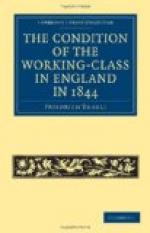to official reports,” as twelve per cent. of
the working-class, which agrees with Gaskell’s
number; the workers being estimated at 175,000, 21,000
would form twelve per cent. of it. The cellar
dwellings in the suburbs are at least as numerous,
so that the number of persons living in cellars in
Manchester—using its name in the broader
sense—is not less than forty to fifty thousand.
So much for the dwellings of the workers in the largest
cities and towns. The manner in which the need
of a shelter is satisfied furnishes a standard for
the manner in which all other necessities are supplied.
That in these filthy holes a ragged, ill-fed population
alone can dwell is a safe conclusion, and such is the
fact. The clothing of the working-people, in
the majority of cases, is in a very bad condition.
The material used for it is not of the best adapted.
Wool and linen have almost vanished from the wardrobe
of both sexes, and cotton has taken their place.
Shirts are made of bleached or coloured cotton goods;
the dresses of the women are chiefly of cotton print
goods, and woollen petticoats are rarely to be seen
on the washline. The men wear chiefly trousers
of fustian or other heavy cotton goods, and jackets
or coats of the same. Fustian has become the
proverbial costume of the working-men, who are called
“fustian jackets,” and call themselves
so in contrast to the gentlemen who wear broadcloth,
which latter words are used as characteristic for
the middle-class. When Feargus O’Connor,
the Chartist leader, came to Manchester during the
insurrection of 1842, he appeared, amidst the deafening
applause of the working-men, in a fustian suit of
clothing. Hats are the universal head-covering
in England, even for working-men, hats of the most
diverse forms, round, high, broad-brimmed, narrow-brimmed,
or without brims—only the younger men in
factory towns wearing caps. Any one who does
not own a hat folds himself a low, square paper cap.
The whole clothing of the working-class, even assuming
it to be in good condition, is little adapted to the
climate. The damp air of England, with its sudden
changes of temperature, more calculated than any other
to give rise to colds, obliges almost the whole middle-class
to wear flannel next the skin, about the body, and
flannel scarfs and shirts are in almost universal
use. Not only is the working-class deprived of
this precaution, it is scarcely ever in a position
to use a thread of woollen clothing; and the heavy
cotton goods, though thicker, stiffer, and heavier
than woollen clothes, afford much less protection against
cold and wet, remain damp much longer because of their
thickness and the nature of the stuff, and have nothing
of the compact density of fulled woollen cloths.
And, if a working-man once buys himself a woollen
coat for Sunday, he must get it from one of the cheap
shops where he finds bad, so-called “Devil’s-dust”
cloth, manufactured for sale and not for use, and
liable to tear or grow threadbare in a fortnight, or




